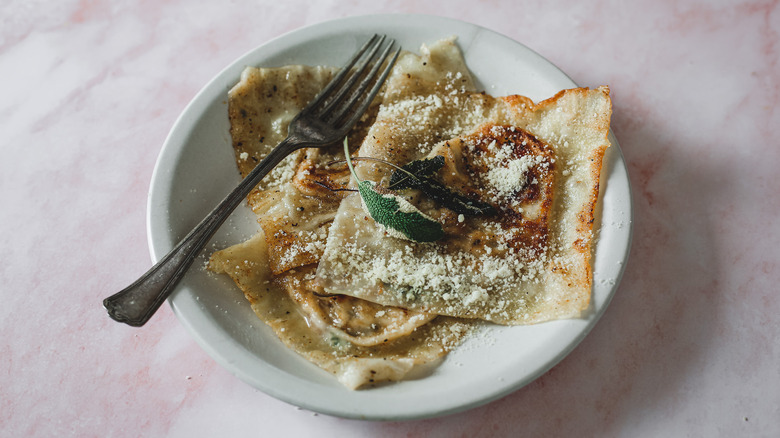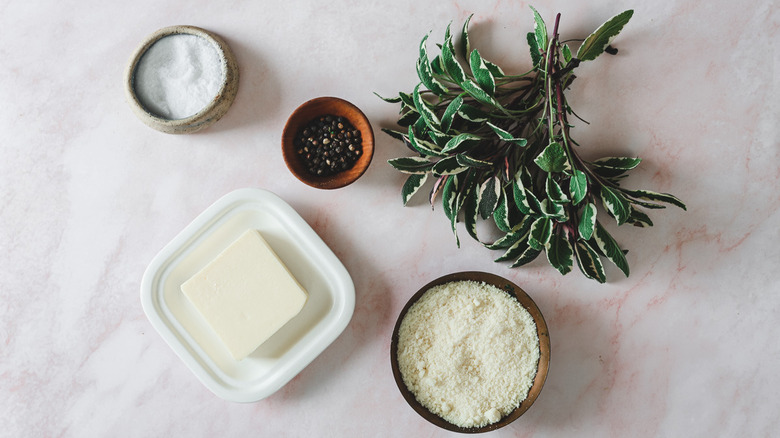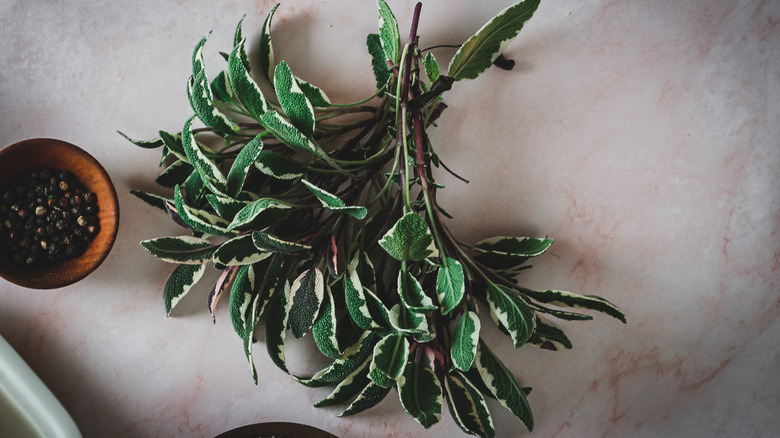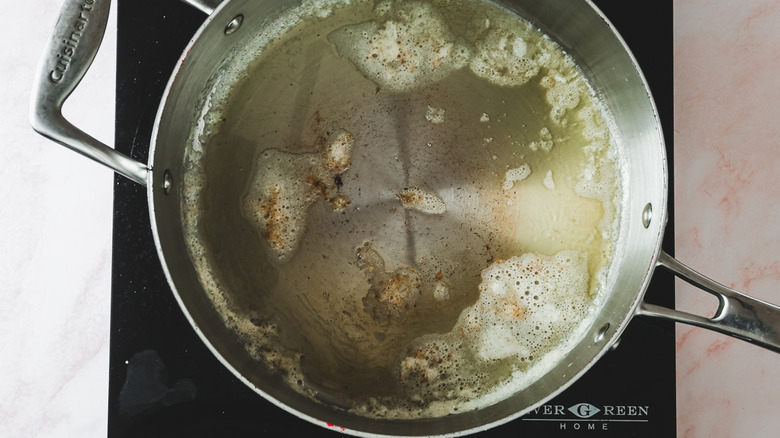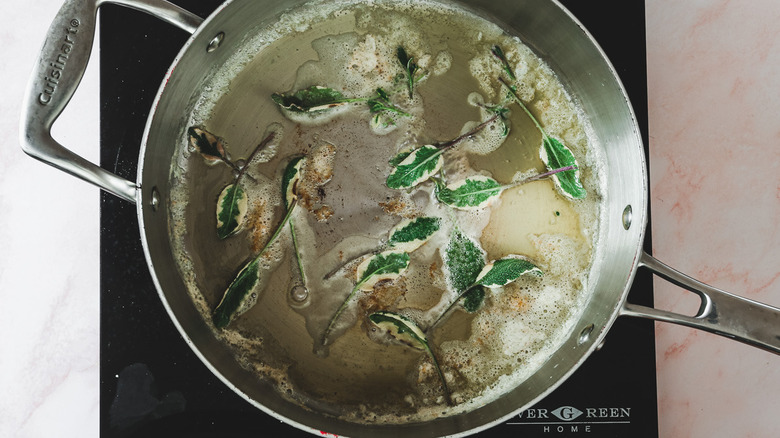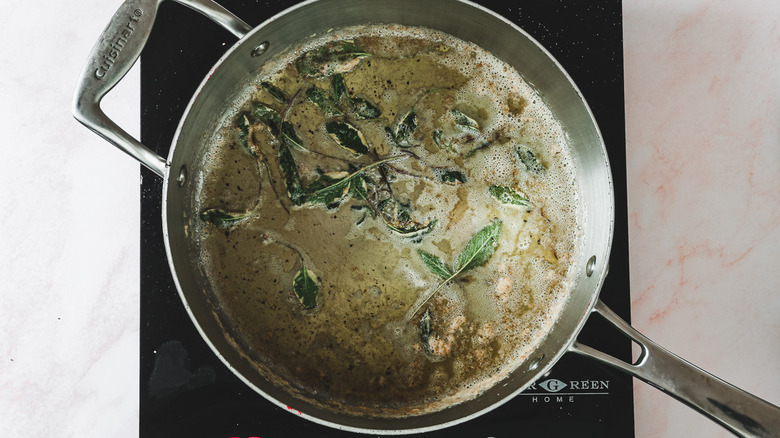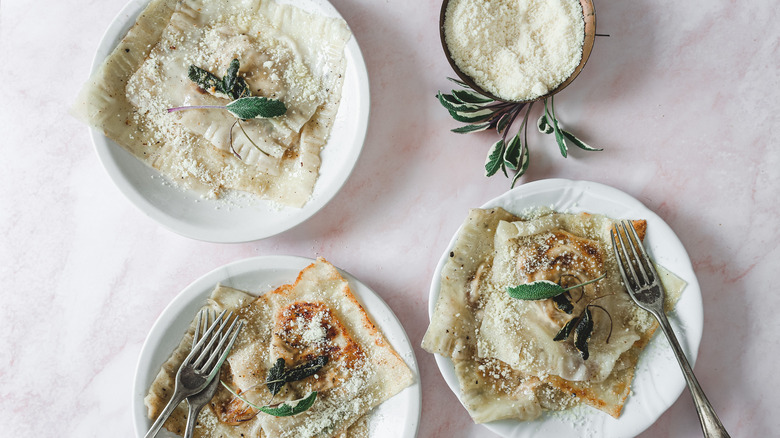Easy Brown Butter Sage Sauce Recipe
Brown butter sage sauce is a magical sauce that turns any meal into a nutty, autumnal delight. Serve it with spaghetti for an easy meal that feels endlessly rich and fancy, or atop homemade ravioli for a special date night dinner. "Fall is about more than just pumpkin spiced lattes and pies," says food blogger & photographer Ksenia Prints of At the Immigrant's Table. It's about slowing down and easing into seasonal ingredients. And nothing represents these things more than taking a few minutes to make nutty brown butter sauce with fresh sage.
The process starts with boiling down some butter until it changes color and the kitchen starts to smell like the best parts of pumpkin pie. Then, you add fresh sage — either whole or diced leaves will do — and finish it all with some salt, pepper, and an optional smattering of Parmesan cheese. That's it!
The resulting three-ingredient pasta sauce is easy, simple and oh-so-fragrant you won't be able to stop yourself from pouring it on everything. It's a natural pairing for pasta of all kinds, but we especially love it over spaghetti or ravioli.
Gather the ingredients to prepare brown butter sage sauce
As befitting an easy, hassle-free, seasonal recipe, the ingredient list couldn't be simpler. There are only three ingredients here!
You will need a stick of butter. Choose unsalted butter of the highest quality you can find. This will be the main ingredient in your sauce, so you definitely want to go for quality here. The second ingredient in this sauce is fresh sage leaves. We love keeping them whole — that way, some of the sage leaves crisp up and can serve as a nice, crunchy decorative element. (But feel free to dice them, if you prefer.) Finally, the last ingredient is seasoning. Feel free to use as much salt and pepper as you like! We basically consider salt and pepper as one ingredient.
What is sage?
Before we get started with this easy-peasy three-ingredient pasta sauce, let's talk about one of the main parts: sage. Sage is an herb that is almost ubiquitous with fall. It's a member of the mint family, and it's a popular ingredient you'll find in holiday stuffing and other Thanksgiving-related recipes (via The Spruce Eats). Sage is known for its bold, savory fragrance, and it can actually be grown year-round in pots or garden plots that don't get frost. Cooked in this brown butter sauce, sage becomes mellow, mild and herbaceous — a great counterpart to the almost-sweet, nutty butter flavor.
Melt the butter in a pan
Start by placing a small saucepan on low-medium heat. We recommend using a stainless steel saucepan, but avoiding nonstick. You are not going to be sautéing anything long enough for it to stick to the bottom, and the stainless steel will enable everything to cook evenly in a short amount of time.
Once your pan comes to the right temperature, add the butter, and cook until it starts to bubble, which should take about one to two minutes. The butter should release a scent. There is no need to cut the butter into cubes — a whole stick will melt a bit slower, but just as well.
Add the sage to the pan
With your butter fully melted and bubbling, it's time to add the herbs! Add the fresh sage to the pan. We like the look of whole sage leaves in this sauce, but if you prefer to avoid biting into a whole herb, feel free to dice the sage into small pieces.
Once the sage has been added to the pan, lower the heat, and cook until the butter smells nutty and starts to turn golden in color, which should take two to four minutes. Do not let the butter actually turn brown, as it will start to burn. We are looking for just a beautiful, mellow golden-brown color.
Season, taste, and correct the seasonings
Now that your butter is done and your sage is slightly cooked, just enough to release all of its oils and aromas, the sauce is basically ready.
Take the pan off heat, and set it aside. Now, get as close to it as you dare, and get a full whiff of the beauty of this brown butter sage sauce. Close your eyes, and image red and golden leaves falling off trees, mugs of warm apple cider, and a crackling bonfire. Don't you feel so much closer to fall already?
Taste the pasta sauce, and season it with salt and pepper to taste. Do not let the sauce cool, but serve it immediately.
Serve your brown butter sage sauce immediately on top of pasta
Serve brown butter sage sauce on top of your favorite pasta (spaghetti, ravioli, etc.) or even potatoes. There are few things that cannot be made better with brown butter sage sauce! We like to add a sprinkling of Parmesan cheese on top if we're serving it with spaghetti, or sometimes even crushed walnuts to bring home the nuttiness of the sauce.
Pair this dish with fall-appropriate drinks: a nice ale or apple cider or even a glass of whiskey or a bourbon cocktail. If you're avoiding alcohol, a cold glass of apple juice would also work magic.
Leftover brown butter sage will keep in a refrigerated jar for a week — but trust us, it won't last that long. This fall-themed recipe is sure to be a family staple in your home.
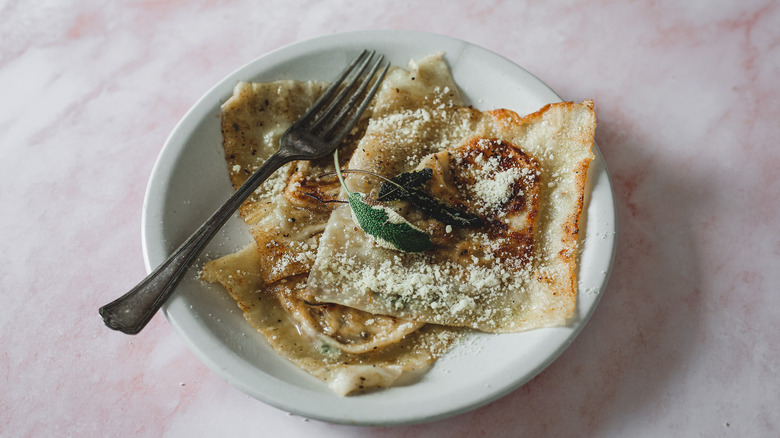
- 1 stick unsalted butter
- 20 whole sage leaves
- salt, to taste
- pepper, to taste
- Set a small saucepan on low-medium heat. Add the butter, and cook until it starts to bubble, about 2 minutes.
- Add the sage, and cook until the butter smells nutty and starts to turn golden-brown in color, about 2 to 4 minutes.
- Season with salt and pepper, to taste.
- Remove from heat, and set the pan aside. Do not let the sauce cool, but serve it immediately.
| Calories per Serving | 219 |
| Total Fat | 23.6 g |
| Saturated Fat | 14.9 g |
| Trans Fat | 0.9 g |
| Cholesterol | 60.7 mg |
| Total Carbohydrates | 3.1 g |
| Dietary Fiber | 2.0 g |
| Total Sugars | 0.1 g |
| Sodium | 77.6 mg |
| Protein | 0.8 g |
